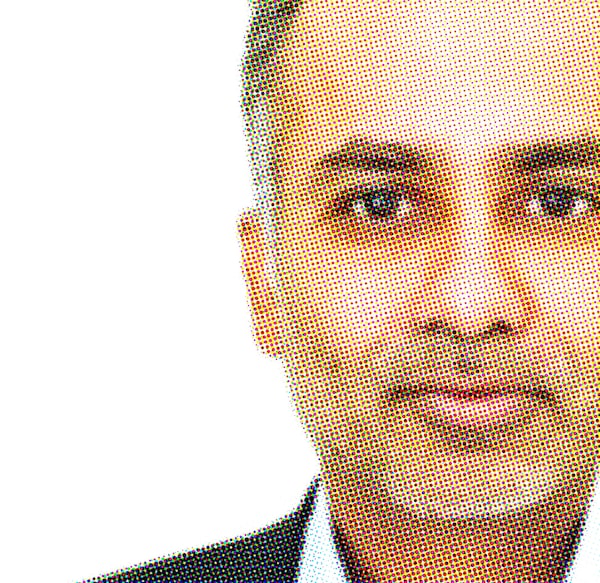
Sayan Navaratnam is CEO and chair of Facedrive Inc., an Ontario-based tech startup that at one point was more valuable than Canadian giants like SNC-Lavalin and Maple Leaf Foods.Photo illustration by The Globe and Mail
Chances are you’ve never heard of Sayan Navaratnam. For many years, he’s operated dull, privately held companies in unglamorous industries: hydraulic systems, IT staffing, call centres. They fall under the umbrella of Mr. Navaratnam’s Malar Group Inc., which he describes in epic terms. “We are a leadership team like no other,” he’s quoted as saying on the company’s website.
One of Mr. Navaratnam’s companies recently joined the echelon of multibillion-dollar Canadian tech startups: Facedrive Inc. After it started trading on the Venture Exchange in September, 2019, its shares soared more than 2,800 per cent to a high in February, and its market cap topped $5-billion, making it more valuable than SNC-Lavalin, CI Financial and Maple Leaf Foods at the time. Mr. Navaratnam became a paper billionaire, owing to his roughly one-third stake.
Facedrive is no mere company, according to its press material. It’s a “multifaceted ‘people-and-planet first’ tech ecosystem.” It operates a bewildering array of businesses: ride-sharing, electric-vehicle subscriptions, food and grocery delivery, COVID-19 contact tracing, and online retail. It’s in the Will Smith business, too, having invested US$1-million in a “content creation” company co-founded by the actor. (The firm, Westbrook, did not respond to e-mails.)

Facedrive is involved a 'content creation' company co-founded by Will Smith, shown here at a promotional event for a new film in early 2020.Carlos Alvarez/Getty Images
Mr. Navaratnam, who is CEO and chair, has attracted prominent supporters. Former Liberal MP Paul Zed is a director, and Phil Fontaine, former national chief of the Assembly of First Nations, is an adviser. In February, the Ontario government announced $2.5-million in funding for Facedrive’s contact-tracing technology. “We look deep into anything that we invest in,” Premier Doug Ford said at a press conference when asked about the funding.
But take even a cursory look at Facedrive, and it’s hard not to be mystified at the valuation. It’s a small company with scant revenue. In the first nine months of 2020, it earned just $747,976 in sales and lost $14.4-million. Because its operations are so minimal, the company funds itself through equity financing. It has no high-profile venture capital backing, and no analyst coverage.
Headquartered in Richmond Hill, Ont., Facedrive is adept at self-promotion, however. Seemingly no development is unworthy of publicity. A mention in the Globe and Mail last year spawned two press releases. A website called OilPrice.com published dozens of articles about Facedrive and hailed Mr. Navaratnam, 46, as a visionary shaping the future of transportation alongside Elon Musk and Jeff Bezos. Disclaimers on the site note the owner of OilPrice.com holds a “considerable” number of Facedrive shares.
For all the accolades, Mr. Navaratnam is not eager to talk. A spokesperson said the company does not normally grant interviews and sent statements to The Globe and Mail through Mujir Muneeruddin, its chief legal officer. He declined to address many questions about Facedrive. Instead, he accused the Globe of racist bullying for inquiring about Mr. Navaratnam’s biography and alleged its reporters were being manipulated by short sellers betting on the stock’s decline.
But Mr. Navaratnam is no neophyte, having worked at a hedge fund and serving as a CEO and director of public companies. Two of his past ventures also operated in trendy sectors, were heavily promoted and saw huge gains in their stock prices – only to crash to earth.
So far, Facedrive has followed the same pattern. The stock price has even fallen 60 per cent from its February peak. It’s still a $2.3-billion company, however – one that touts its revolutionary potential, even as it loses money. Its ascent in the market, even during frothy times for tech stocks, is an anomaly. And it’s a company whose biggest shareholders are battling in court over hundreds of millions of dollars.
Where the firm goes from here is anyone’s guess. But the biggest mystery of all is just why Facedrive is a multibillion-dollar company in the first place.
In 2016, Uber and Lyft were already locking up the ride-sharing market. But Imran Khan and Junaid Razvi thought there was room for another player, and hatched the idea for Facedrive. Passengers could select hybrid or electric vehicles, and a portion of their fares would be set aside for tree-planting. The company’s contributions allowed more than 5,200 trees to be planted, according to Forests Ontario, an environmental organization. Overall, Facedrive has focused on environmental, social, and governance (ESG) initiatives, also donating money to fight child marriage in Bangladesh.
More than a year passed before Facedrive secured a licence to operate in Toronto and another year went by before it started operating in the city. A few months prior to launch in 2018, Mr. Navaratnam’s firm invested in Facedrive after being approached by Mr. Khan, a real estate agent. In a press release, Mr. Navaratnam declared Facedrive would “quickly become the technology of choice.”
In 2019, Facedrive went public on the Venture Exchange through a reverse takeover, with Mr. Navaratnam as CEO, chairman and largest shareholder. Mr. Khan appeared to have no operational role, according to the filings, though he remains the second largest shareholder.
Mr. Navaratnam was already a wealthy man before Facedrive. He owns a mansion north of Toronto with a tennis court, and a suite at the Shangri-La, a luxury hotel condominium in the city’s downtown. He commands a fleet of high-end cars that includes three Lamborghinis, a Tesla, and a Bugatti Chiron Sport, which sells for about US$3.3-million.
He wasn’t always rich. He spent his adolescent years in a middle-class neighbourhood in Scarborough. In his 20s, he worked at a technology company called Satellite Communications Inc. His talent stood out and he was fast-tracked to CEO, said Cindy Farrell, a former managing director. “His focus was astounding, and always on the business, not on himself,” she wrote in an e-mail.
Ms. Farrell’s father founded the company, and after he died following a long illness, the family sold. She credits Mr. Navaratnam for maintaining the company in her father’s absence. “It was astonishing that such a young person was so adept in business,” she wrote.
He later worked at other tech firms, usually in the security space and areas related to telecom, and became a partner at a hedge fund before his current role at Facedrive.
Not long after the company went public in 2019, the share price skyrocketed. Between January and July, 2020, it grew 960 per cent. A Facedrive investor presentation in March, 2020, outlined how its environmental ethos and brand partnerships (including with Will Smith) would help build the “ride-sharing platform of the future.” The company said at the time it had signed up more than 13,000 drivers.
Facedrive's app launches on a smartphone.Ryan Carter/The Globe and Mail
Available data from cities where Facedrive has said it operates show it has a fraction of that amount. Figures supplied by Toronto, London and Hamilton show Facedrive has 1,119 registered drivers. Orillia would only confirm Facedrive has fewer than 26 drivers in town. (Ottawa and Guelph did not provide exact figures.) Facedrive has said in the past it operates in Kitchener, Waterloo and Cambridge, but a spokesperson for the Region of Waterloo said it does not currently have a licence.
A lack of drivers is evident when trying to book a ride. In Toronto, wait times were typically between 10 and 20 minutes, and few cars were available whenever a Globe reporter checked multiple times over the past few weeks. While Facedrive touts its dedication to the environment, there were zero electric vehicles available, and hybrids were rare.
After Facedrive launched last year in Orillia, a small city north of Toronto, Larry Radzio signed up as a driver. After he registered, he flipped on the app, and waited. “I sat there for a few hours, and I wouldn’t get anything,” he said. Mr. Radzio estimates he’s completed fewer than 10 rides with Facedrive during that time. Some of the trips were scheduled by riders in advance.
Ride-sharing brought in more than half the company’s revenue during the first nine months of 2020. (It has yet to file year-end results.)
According to Mr. Muneeruddin, the chief legal officer, the pandemic hurt demand for ride-sharing. “This, in turn, had a number of knock-on effects including pausing the company’s planned expansions into new cities, delays in renewals of Facedrive’s licences at the municipal level, and a reduction in registered and active drivers,” he wrote.
Even before COVID-19, the business was small: revenue from rides, after paying out drivers, totalled $349,104 in 2019. The company’s valuation was seemingly immune to any pandemic-induced slowdown, and Facedrive ended 2020 worth $1.5-billion.
But for Mr. Navaratnam, inflated valuations and wild stock price swings are nothing new.
Larry Radzio of Orillia, Ont., signed up last year for Facedrive's ride-sharing app, but estimates that he's completed fewer than 10 rides with the service so far.Ryan Carter/The Globe and Mail
In 2004, Mr. Navaratnam got into business with a New York hedge fund called Laurus Capital Management LLC. The fund was run by brothers Eugene and David Grin, who filled a niche by lending money to companies that traded for pennies on over-the-counter exchanges.
That year, the Grins and Mr. Navaratnam took a security technology firm of his public through a shell company called Creative Vistas. The company emphasized security spending had ballooned since the terrorist attacks of September 11. “It’s no secret that the homeland security sector is an explosive market,” reads an article the company paid for on a now-defunct stock promotion site.
Creative Vistas made a few acquisitions, the largest of which was Cancable, a provider of installation services primarily for Rogers Communications Inc. In the summer of 2006, Mr. Navaratnam wrote in a letter to shareholders the company was about to launch an “aggressive” investor relations strategy. Its shares, which traded for pennies, exploded more than 500 per cent between January and August, 2007.
While the stock was booming, the company was losing money and in debt to Laurus for nearly US$16-million. Revenue was growing (sales totalled nearly US$40-million in 2007) but its auditors had concerns about recurring losses: “These factors raise substantial doubt about the company’s ability to continue as a going concern,” the auditors wrote in the 2007 annual report.
The shares crashed the next year, even before the global financial crisis hit that fall. By June, the share price had fallen nearly 70 per cent. Mr. Navaratnam, who served as chair, and Laurus appear to have held on to the majority of their stakes throughout the boom and bust.
In 2011, Creative Vistas sold its largest division, Cancable, to an affiliate of Laurus for one dollar. Shares had already collapsed 99 per cent from the peak in 2007.
By then, Mr. Navaratnam was working directly for Laurus as a partner, senior managing director and member of the management committee. That relationship led him to another penny stock in a hot sector, the nascent biofuels industry.
The stock was PetroAlgae Inc., a Florida-based company that said it was close to achieving the first large-scale commercialization of a technology capable of extracting fuel from algae. The company warned that short-term profits might be elusive, but in the long run, it hoped to licence its technology around the world, allowing anyone to operate their own algae, micro-crop farm.
Laurus took PetroAlgae public through a reverse takeover in 2008, and Mr. Navaratnam was appointed to the board. PetroAlgae then tapped one of his companies for consulting services, paying in shares valued at US$3.15-million at the time, according to public filings.
Within PetroAlgae, Mr. Navaratnam was seen as Laurus’s eyes and ears. He brought much needed discipline, according to a former executive with the company.
But that discipline did not translate into sales. Despite signing multiple memorandums of understanding with potential partners in China and India, the company never reported any revenue and turned in huge losses—including US$30-million in 2009—all while racking up debt to Laurus. The former PetroAlgae executive said Mr. Navaratnam and Laurus remained committed, even though evidence showed the company was far from profitability. (The Globe is not naming the source because he is not authorized to discuss PetroAlgae publicly.)
If PetroAlgae’s stock price is any indication, some investors were believers, too. The stock hit a high of $26.75, making the company worth nearly US$2.7-billion. It’s unclear what caused the spike; PetroAlgae attributed the swings to low trading volume. Regulatory filings show no sign the Grin brothers or Mr. Navaratnam sold their stock.
In the end, the technology never took off. By the end of 2012, the stock price had plummeted to 85 cents and PetroAlgae took on a new name and mission. The company that set out to upend the fuel industry now sells protein powder made from water lentils.

Product information from Facedrive's website describes the devices it offers for COVID-19 contact tracing.
Mr. Navaratnam’s eclectic approach to business – security, telecom, algae – is readily apparent at Facedrive. After the pandemic hit in March, 2020, the company shifted gears from ride-sharing and announced it was developing a COVID-19 contact-tracing technology with the University of Waterloo. Dubbed TraceSCAN, the wearable tech uses Bluetooth connections to log contacts and vibrates or beeps if users aren’t distancing. It’s supposed to supplement the federal government’s COVID-19 Alert app in settings where smartphone use is limited or not permitted, such as construction sites.
According to the company’s press releases, Waterloo professors Patricia Nieva and William Melek led a team that implemented artificial intelligence to identify a wide network of potential contacts after a positive case. Both professors were quoted in multiple press releases and appeared in a video, but neither returned e-mails and calls from The Globe.
Facedrive quickly found supporters. The Labourers’ International Union of North America (LiUNA), which has 130,000 members in Canada, announced it would adopt TraceSCAN, run a pilot project at a construction site, and then endorsed the device for use across its work sites.
The test happened not on a construction site, but at a LiUNA training facility with 25 participants over a few weeks. “We wanted to ensure we ran the initial pilot project in a controlled setting to closely monitor the effectiveness and functionality of the technology,” said spokesperson Victoria Mancinelli in an e-mail. “The pilot project was a great success.” She did not answer a question about how the results were assessed, nor is she aware of any construction sites using TraceSCAN today.
Facedrive also made in-roads with the Ontario government. After a briefing with officials last year, Monte McNaughton, the Minister of Labour, Training and Skills Development, wrote a supportive letter to Facedrive. Then the company issued a press release, stating the government “endorsed and supports the deployment” of TraceSCAN. The letter, obtained by The Globe and Mail, was more circumspect, noting that the technology could fill a gap and encouraged the company to advance TraceSCAN.
Mr. McNaughton also referenced a TraceSCAN “pilot project with LiUNA and their over 200 members with EllisDon currently working on the Parliament Hill renovations in Ottawa,” noting the government would monitor it “with great interest.” His statement was news to EllisDon. A spokesperson for the construction giant said TraceSCAN was not used on-site, and the Ottawa office is “completely unaware of the software.”
Still, TraceSCAN was seen by the government to be promising enough to receive $2.5-million in February through a fund to support businesses developing technology to combat COVID-19. A promotional video tweeted by Economic Development Minister Victor Fedeli said the funding would enable Facedrive to manufacture 150,000 devices “right here in Ontario.”
What exactly the company will build in the province is not clear. Facecdrive told The Globe it sources the hardware for TraceSCAN in China and the U.S. There are similar products for sale in bulk from Chinese manufacturers through Alibaba.com. One company, called KKM, sells contact tracing wearables that appear identical to both versions of TraceSCAN, right down to a small fingerprint decal on one variety. KKM can customize the hardware for buyers by applying logos, and provides a software kit to integrate with other applications. In bulk, they cost a few dollars each.

A wearable device advertised on Facedrive's website, left, compared with a similar KKM-made device from Alibaba.com.
An instruction page that comes with TraceSCAN is identical to one in KKM’s manual. Further, records show Facedrive certified nine wireless devices with Innovation, Science and Economic Development Canada, seven of which have model numbers that are the same as KKM’s wearables.
“The Globe’s suggestion that Facedrive is simply selling wearable bands readily available on Alibaba is not the case,” the company said. In a letter to The Globe, Facedrive said the value of TraceSCAN is its proprietary software. The company has also customized the technology, it said, such as by adding a feature to “pinpoint locations of potential COVID-19 contamination.”
TraceSCAN is used in a few places. Air Canada has tested the technology over the past few months. “We are still analyzing the data,” a spokesperson said, “but the employee response was very positive.”
Riverside Natural Foods deployed TraceSCAN to its 400 employees across its facilities in Toronto. “They’ve been very co-operative from the onset in terms of the software updates and the modifications we needed,” president Nima Fotovat said of Facedrive. “And I love the fact that they’re local.”
It’s not just businesses, either. Waywayseecappo, a First Nations community of about 2,800 people in Manitoba, is also deploying TraceSCAN. Chief Murray Clearsky said the community was introduced to Facedrive through Mr. Fontaine, and agreed to run a pilot project in December before adopting the technology more widely. Between 300 and 350 devices have been issued so far in the community, which has seen 13 cases of COVID-19 since the start of the pandemic.
While Facedrive said in January the pilot was completed, Chief Clearsky said more evaluation was underway. “If it works, then we pay. If it doesn’t, then we don’t,” he said. So far, the response from the community has been positive and other First Nations have called Chief Clearsky to ask about the devices.
A few days after Waywayseecappo said it would adopt TraceSCAN, Facedrive closed an investment round that included participation from members of a First Nations community, according to a press release. Chief Clearsky could not say whether Waywayseecappo invested until he talked to the community’s financial advisers. “They give us a total breakdown of where they invested our money,” he said, “but I think it was two, three weeks ago that I said, ‘Yeah, you should.’”

Waywayseecappo First Nation members show a delivery of TraceSCAN trackers in late January. Chief Murray Clearsky said the Manitoba community learned about Facedrive through Phil Fontaine, former national chief of the Assembly of First Nations.
Others are not convinced Facedrive is a sound investment. In July, short seller Hindenburg Research published a report calling Facedrive a “stock promotion with a hollow core.” Of note was an agreement Facedrive signed with an obscure company called Medtronics Online Solutions Ltd. for “marketing and strategic consulting services.” Facedrive paid in shares valued at $8.2-million, which, at the time, was more than the company’s operating expenditures over the previous year. Hindenburg found Medtronics was linked to OilPrice.com, the site that published many glowing paid articles about Facedrive.
Facedrive chief legal officer Mr. Muneeruddin wrote to The Globe that “Facedrive has come under attack” from hedge funds “seeking to burn Facedrive’s business to the ground and profit from the ashes.” He suggested that because of the strength of the company’s share price, hedge funds selling short cannot exit without suffering losses.
“Given Facedrive’s current stock prices, the short sellers could not possibly cover the short, and therefore have put themselves in an existential battle with Facedrive,” he wrote.
Most of the company’s shares—nearly 86 million, according to its most recent financials—are under contractual lock-up restrictions, meaning they cannot be sold. Lockup agreements are commonplace when a company goes public, ensuring that insiders stay committed to building shareholder wealth long-term, rather than making a quick exit. A company can better maintain its valuation, too; if insiders unload significant stakes, it could depress the stock price.
Since Facedrive went public, it has taken steps to continue to keep insiders locked up, according to allegations made in court documents.
One of those insiders was Nauman Kureshy, who says he was provided with shares as a reward for, among other things, introducing Facedrive co-founder Imran Khan to Mr. Navaratnam. When the company went public in 2019, Mr. Kureshy alleges, he was pressured to sign a lock-up agreement, and Mr. Navaratnam and two other executives “threatened” they wouldn’t register his shares at all if he didn’t sign. Mr. Kureshy refused, arguing Facedrive had no legal basis for doing so.
He alleges the company responded by refusing to register his shares with the company responsible for officially recording Facedrive’s security holders. Mr. Kureshy is suing Facedrive and its executive team for $1.6-million, the value of his stake when he launched his lawsuit in 2020.
Facedrive declined to comment on Mr. Kureshy’s allegations, but said they are “actively being defended in court.”
Facedrive is also manoeuvring to force co-founder Mr. Khan, who no longer has a role, to disgorge his 25 per cent ownership stake and have it placed in a trust. On March 29, two days before Mr. Khan’s lockup restrictions were to start expiring, Mr. Navaratnam filed a lawsuit that alleges Mr. Khan misled him to secure his initial investment in Facedrive. Mr. Navaratnam claims he was led to believe the company’s ride-sharing software was “cutting edge” and built by the creator and lead developer of Skype. Only after investing in 2018, he alleges, did he learn the software was plagued with problems and required substantial funding. Facedrive had been “near collapse,” with few drivers and no revenue.
The suit also claims Mr. Khan breached the terms of his lock-up agreement by pledging his Facedrive shares in exchange for loans for a real estate development. “It would be unconscionable to allow Imran to profit from Facedrive’s success as he had no role in it,” according to the claim.
Mr. Navaratnam is not only seeking $12-million in damages, but the value of Mr. Khan’s shares – about $503-million.
In an e-mailed statement to The Globe, Mr. Khan said that he had yet to be served with the claim, and that he believes it was drafted to cast untrue aspersions about him with other shareholders. He said the claim “is without any factual or legal merit.”
Mr. Navaratnam’s own lockup provisions were set to start expiring in March, too. On March 8, however, Mr. Navaratnam extended the period for two years, while two other executives extended for an additional year. “As the initial lock-up period came to an end, we felt it was necessary to assure the market that we had no plans to sell our shares and that we are all in this for the long term,” Mr. Navaratnam said in a press release. (A day later, Medtronics put out its own release announcing a one-year lock-up extension for its shares.)
For Mr. Navaratnam to cash in on his substantial stake, worth about $714-million, Facedrive has to maintain its valuation. The question is how. TraceSCAN faces challenges now that Canadians are getting vaccinated, though the company said it can expand into “digital passports.” Ride-sharing retrenched during the pandemic. Facedrive runs an online marketplace selling tech gadgets and accessories, but it earned just $8,597 in revenue the first three quarters of 2020.
The company bought an electric vehicle subscription service called Steer last September, but it’s just getting started. Steer was only available in Washington, D.C., at the time of the purchase, and expanded to a second city, Toronto, in March.
The company started developing its own food delivery app, but ended up purchasing a small Toronto company called Food Hwy. Facedrive said it expects Food Hwy to bring in $10.5-million in revenue in 2020, and once combined with its own food delivery business, $30-million this year. (Before the acquisition, Facedrive made just $1,953 through its own service.)
The company itself has no doubts about its prospects. “Facedrive is highly confident in and committed to its business model and believes increases in its market valuation reflects that same investor confidence,” Mr. Muneeruddin wrote to The Globe. He himself is committed, too. “I truly believe Facedrive is going to change the world,” he wrote.
Tonya Flouro-Catlin, who lives in the U.S., is also among the faithful. Part of a small Facebook group for retail Facedrive investors, she owns just a few shares. “I know it’s not a lot,” she wrote in an e-mail last month. “But it is to me, especially on a fixed income.” She had been researching stocks when she came across Facedrive, and was struck by the company’s mission. She had a good feeling about it, and told others about it, too. “I feel that this company has huge potential to really expand ... and could be [the] next Amazon,” she wrote. “I truly believe in this company.”
Your time is valuable. Have the Top Business Headlines newsletter conveniently delivered to your inbox in the morning or evening. Sign up today.
 Joe Castaldo
Joe Castaldo Greg McArthur
Greg McArthur